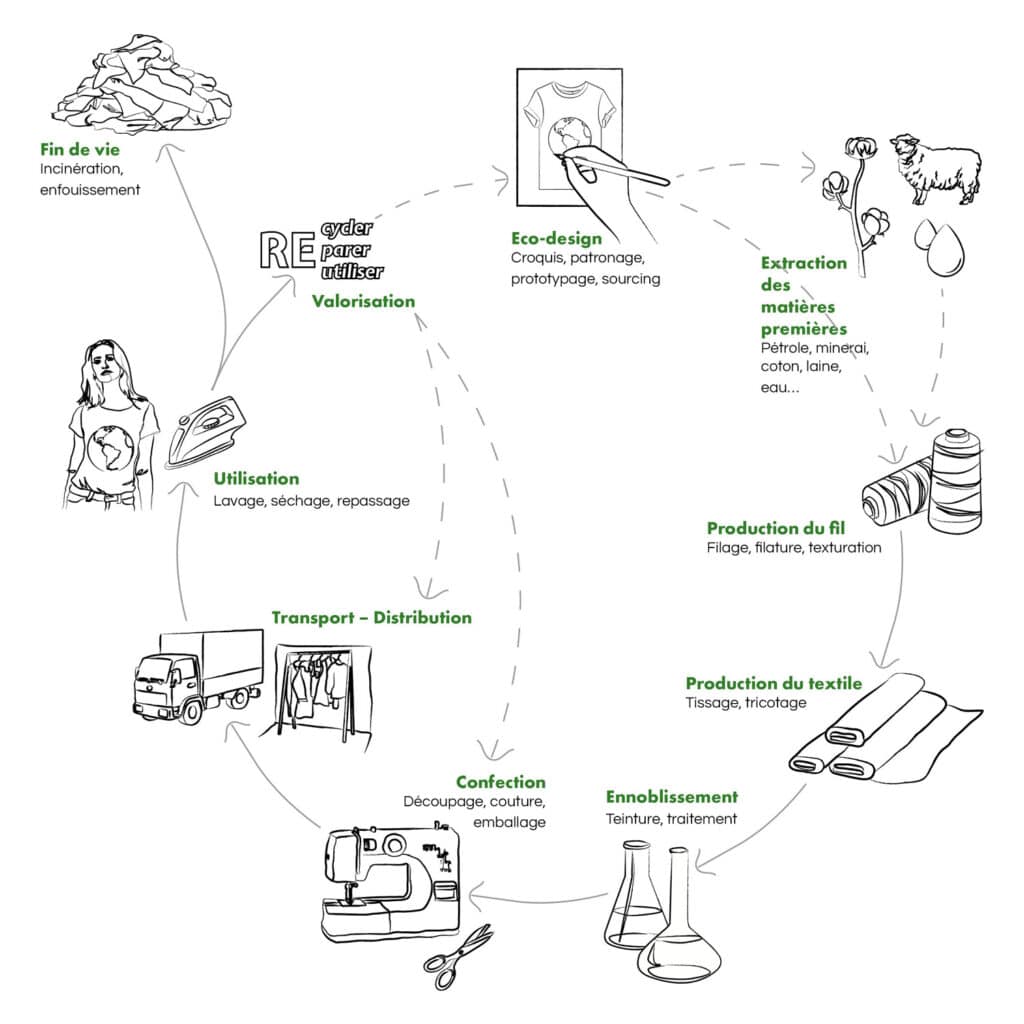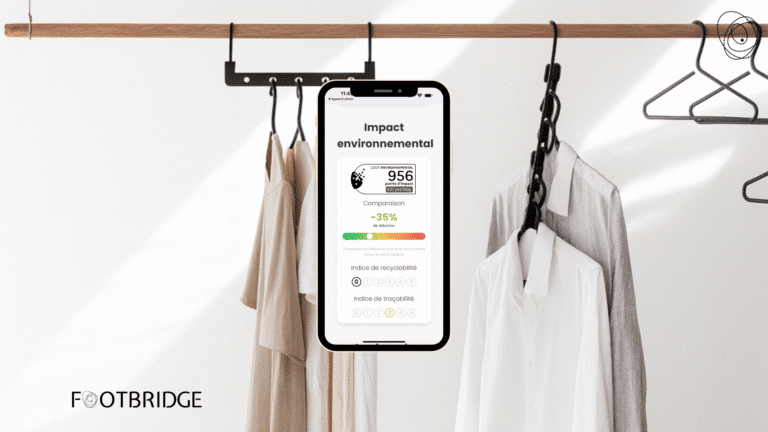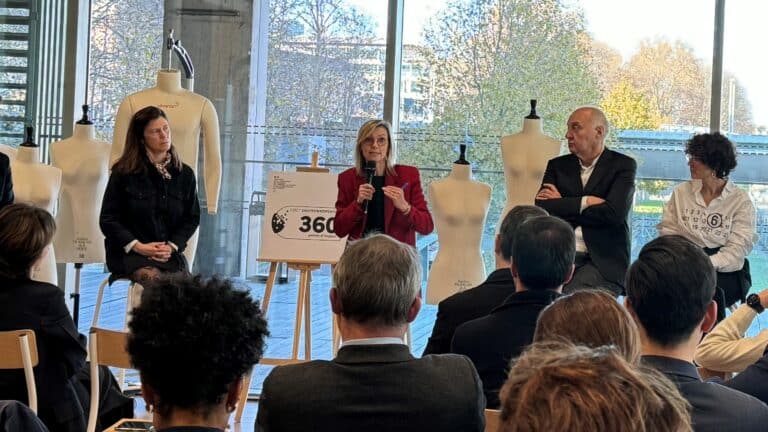The fashion industry is one of the most polluting industries in the world, but you already knew that, right? In addition to massive water pollution, it significantly contributes to global warming, accounting for nearly 10% of global greenhouse gas emissions. The production of synthetic fibers alone, responsible for 40% of the textile industry’s emissions, reached a historic peak in 2021 with more than 113 million tons produced. The situation is not much better for natural materials like cotton, as they require large amounts of water and energy to produce…
Sommaire
What is sustainable fashion?
Sustainable fashion is a term used to designate fashion that takes into account the environmental and social impact of clothing production. Brands committed to this approach use natural and sustainable materials, which may be recycled or organic. They also use more environmentally-friendly production methods and improve working conditions for textile workers.
This approach has already led to the creation of such committed brands as :
- Picture Organic :Their entire collection is produced using organic, recycled, and bio-based materials (organic cotton, recycled polyester, etc.). The brand also focuses on improving working conditions in factories.
- Marine Serre : A French fashion designer who uses upcycling to create her garments.
- Ecoalf :This Spanish brand offers clothing made from 100% recycled materials such as plastic bottles, tires, nylon, etc. The collected waste is transformed into textile fibers to create sustainable and eco-responsible collections.
- Veja :A French sneaker brand that combines style, ethics, and sustainability. This brand uses vegan materials and recycled materials in their products and works with small local factories using environmentally friendly manufacturing methods.
What’s at stake in this fashion?
Economic issues
The fashion industry generates many billions of dollars every year, and many brands are not yet ready to change their unsustainable production methods for fear of losing profits.
However, as consumers become more aware of the environmental and social impact of the clothing industry, they are increasingly demanding clothes made from sustainable materials, and want to help reduce these impacts. Finally, many see sustainable fashion as a way of investing in the future of our planet.
Therefore, the industry needs to start taking sustainability seriously. If it fails to do so, it will lose ground to brands already committed to this path. The movement is underway, and many brands are embarking on a path of progress with environmentally-friendly production methods, recycled materials and sustainable models in the years to come.
Environmental issues
With its colossal environmental impact, fashion has come under increasing scrutiny in recent years. Clothing production uses more than half of the world’s fossil fibers, as well as other natural resources, and generates significant pollution on the planet. Not to mention the often catastrophic working conditions for textile workers, but we’ll come back to that later.
That’s why the aim of sustainable fashion is to extend the lifespan and reduce the environmental impact of clothing. To achieve this, brands must take action at every stage of their products’ life cycle:
- garment design (sketching, prototyping, etc.)
- Raw materials extraction (cotton, water, wool, oil, etc.)
- Manufacturing (location, manufacturing method, conditions, fabric and thread production, etc.)
- Dressmaking (seams, assembly of parts…)
- Transportation and distribution
- Use and washing
- Recycling and end-of-life

Social issues
As well as being known for its damaging impact on the environment, the fashion and textile industry is also known for the dangerous and arduous working conditions of its workers.
However, the problem persists because of the profitability of maintaining a low-cost workforce. It’s also worth noting that the majority of workers in textile factories are women, and that they suffer discrimination and violence in the workplace. The laws in these Asian countries do not allow women victims of such insults to assert their rights, as no protective measures are in place to help them.
Sustainable fashion aims to put an end to these unacceptable conditions by supporting fair labor practices. It offers workers a fairer wage, safer working conditions and access to healthcare and education that they didn’t have before.
Calculate the eco-score of your clothing
Master the environmental impacts of your designs with our dedicated platform.
Schedule a demoThe manufacturing process for sustainable clothing
To make clothing more sustainable, it’s essential to ensure that the manufacturing process is as environmentally friendly as possible. This includes using existing, energy-efficient production methods, innovating and collaborating to accelerate progress, and developing new emerging materials and regenerative agriculture.
To this end, the materials used in the sustainable textile manufacturing process are plant- or animal-based, recyclable and recycled, natural, transitional or organic.
The sustainable fashion industry can also use chemical materials, provided they are obtained from renewable sources or a “clean” chemistry process.
Certifications and labels
Brands committed to the environment can have their products certified with an ecolabel. These labels verify that products are manufactured in sustainable and ethical production sites. Once validated, garments carry a logo on their label attesting to their eco-design.
There are several certifications for sustainable materials. The best-known are :
- Global Organic Textile Standard (GOTS) : for products made from at least 70% natural organic fibers.
- Global Recycled Standard (GRS) : for recycled fibers
- RWS : sustainable wools
- Bluesign® : for products with reduced environmental impact
- Oeko-Tex : certification of the finishing stage for products that do not contain harmful chemicals

Garment traceability
Traceability means that you can follow the garment’s manufacturing process from the extraction of raw materials to the finished product. More and more players in the textile industry are providing detailed information on the provenance of their garments. To be sure you’re buying a product from a committed brand, you need to make a habit of checking the traceability of garments.
This is exactly what FOOTBRIDGE has done with its QR codes and traceability labels.
By buying clothes from a sustainable fashion brand, you can be sure you’re supporting an environmentally responsible company. Sustainable fashion is not just a trend, it’s the future of the fashion industry.
How can FOOTBRIDGE help you?
FOOTBRIDGE is an innovative new solution for the fashion and apparel industry, offering transparency at every stage of product production. GOOD FABRIC’s SaaS eco-design and lifecycle analysis services enable textile companies to better control their manufacturing conditions while meeting consumer expectations.
Here are just a few of the brands we support that use Footbridge on a daily basis: Ami, Aigle, Longchamp, Petit Bateau, Gerard Darel.
Beware of Greenwashing…
“Greenwashing refers to the practice of presenting a brand or marketing a product by misleading consumers about its social and environmental benefits. The aim is to attract socially responsible customers without making a real commitment, in order to avoid the investments needed for the energy transition. “Source: TheGoodGoods

As you will have gathered, greenwashing is a marketing technique used by some companies to make consumers believe that their products are environmentally friendly, when in fact they are not, all to avoid the higher costs of production (safer labor and installation in particular).
So, when looking for sustainable clothing, it’s important to research the brand in question and be an informed consumer. Check the labels, certifications and materials of the products you’re interested in to make sure they’re truly environmentally friendly.
How to reduce environmental impact in the textile industry?
It is estimated that the textile industry is responsible for between 3% and 10% of global greenhouse gas emissions. This figure is bound to rise as demand for clothing continues to grow. But there are ways of reducing your environmental impact, and starting to act at your own level by consuming better.
Choosing quality, eco-designed and socially responsible clothing
The quality of a garment largely determines its lifespan. Some people talk about the durability of a product. Of course, choosing a quality garment to wear longer is the basis for more responsible consumption. A quality item costs more than a fast-fashion product, but in the end you’ll benefit from not having to change it too often. Buy less but better!
Eco-designed garments mainly use bio-sourced materials, such as organic cotton (GOTS certified), or recycled materials such as recycled polyester (GRS certified). Few products are fair trade certified, but a finished product with the GOTS logo integrates respect for social standards throughout the manufacturing chain.
It’s not always easy to find your way around the various labels: which ones are serious? which ones are less so? but more and more information is available, notably on the GOOD FABRIC website.
Favoring second-hand
Clothes are something we’re all addicted to, and the big brands in the textile industry understand this. They naturally encourage consumers to buy their products, and to renew them every season, which is not at all environmentally friendly.
So one way to reduce your ecological footprint is to buy second-hand clothes and give them a second life.
Several online platforms offer a second-hand service, such as Vinted or Vestiaire Collective, where you can find and trade items that have sometimes never been worn, and at very attractive prices! More and more brands are also offering second-hand products.
Take care of your clothes
You can also reduce your environmental impact by taking good care of your clothes. This means washing them less often, in cold water, and air-drying them as soon as possible. But it also means repairing or transforming them when damaged, to reduce the amount of waste produced by the textile industry, rather than throwing them away.
Transforming your old clothes
There are many ways to give new life to your old clothes. You can transform them into something else, or wear them in a different way. It’s a great way to be creative and sustainable at the same time!
For example, if you have an old pair of worn-out jeans, you can turn them into summer shorts, or reuse the denim material to repair or add to other garments.
The European textile industry is also investing heavily in building circular recycling channels which, in the years to come, will make it possible to recreate a new garment from a used product.
As you will have gathered from this article, the textile industry is extremely polluting. But the process of reducing its impact is underway, and the pace of change is accelerating, even if we’d like things to move faster.
At your level, it’s possible to take action by reducing your environmental impact a little more each day, by taking the reflex to do a little research on the brand and the product before buying it. By modifying our habits little by little, the fashion industry will have to make the choice to follow a more equitable and sustainable direction for the planet.






